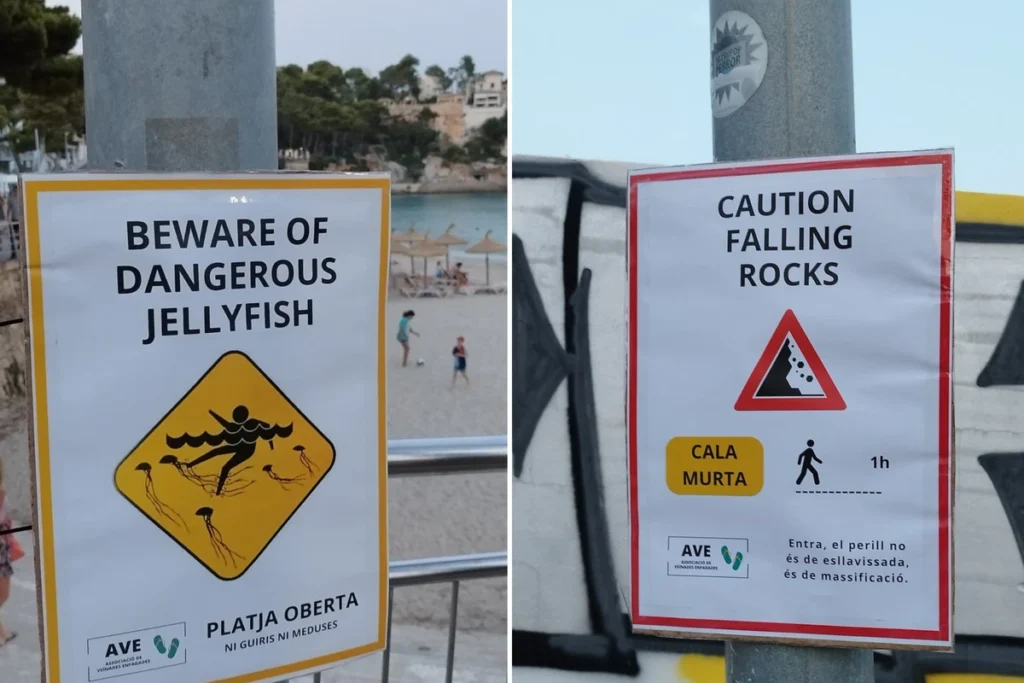
Spain’s Controversial Approach: Signage Strategy Aims to Dissuade British Tourists from Crowded Beaches
Spain, a perennially popular destination for British tourists seeking sun, sand, and relaxation, has adopted an unconventional strategy to manage overcrowding on its beaches. The country’s deployment of misleading signs at select beaches, purportedly designed to deter British tourists, has sparked a mix of reactions and discussions. This comprehensive report delves into the motivations behind Spain‘s signage approach, the implications for British tourists, and the broader considerations of sustainable tourism management.
Managing the Tourism Surge
Spain’s breathtaking beaches, vibrant culture, and pleasant climate have made it a sought-after vacation spot for British tourists. However, the influx of visitors, particularly during peak travel seasons, has led to challenges such as overcrowding, strain on local resources, and concerns about the preservation of natural environments.
In response, some Spanish municipalities have resorted to unconventional measures to manage tourism surges and strike a balance between hosting visitors and safeguarding the integrity of their destinations.
Misleading Signs: The Approach Explained
The practice of using misleading signs to deter British tourists involves posting signage that exaggerates the negatives of a particular beach or area. These signs may highlight non-existent hazards, poor amenities, or other perceived drawbacks, aiming to dissuade potential visitors. The intention behind this strategy is to redirect tourists to less crowded or more environmentally sensitive locations, thus relieving pressure on popular beaches and minimizing the impact of mass tourism.
While proponents of this approach argue that it helps alleviate overtourism and protect delicate ecosystems, critics raise ethical concerns about intentionally deceiving tourists and potentially damaging the reputation of certain destinations.
The Impact on British Tourists
For British tourists, the experience of encountering misleading signs upon arrival at a destination can be confusing and frustrating. Visitors who may have been looking forward to enjoying a particular beach may feel disillusioned or misled by the negative portrayal presented by the signage.
The emotional impact on tourists raises questions about the ethics of employing such tactics. While the goal of managing overcrowding is valid, the methods employed to achieve this objective prompt discussions about transparency, honesty, and the mutual respect between hosts and visitors.
Sustainable Tourism Management
The use of misleading signs in Spain’s efforts to manage tourism aligns with broader discussions about sustainable tourism management. Overtourism, environmental degradation, and cultural disruptions have led destinations worldwide to seek ways to balance the economic benefits of tourism with the preservation of local culture, environment, and quality of life.
The ethical dilemma of using misleading signs underscores the challenges that destinations face in their pursuit of sustainable tourism. Striking a balance between attracting visitors, maintaining cultural authenticity, and preserving natural beauty necessitates careful planning, innovative solutions, and a commitment to responsible tourism practices.
Local Perspectives and Considerations
The use of misleading signs has sparked conversations within local communities and among stakeholders in the tourism industry. While some welcome the strategy as a means of managing visitor flows and safeguarding cherished locations, others express concerns about the potential negative impact on tourism perception, economic contributions, and the overall visitor experience.
The viewpoints of local residents, business owners, and tourism professionals highlight the complex interplay between short-term solutions and long-term sustainability. The challenge lies in finding approaches that effectively manage tourism pressures without alienating visitors or compromising the local identity.
Balancing Transparency and Strategy
The deployment of misleading signs in Spain raises questions about the fine line between transparency and strategic management. While some argue that transparency is essential for maintaining trust between tourists and destinations, others contend that strategic interventions are necessary to address immediate challenges and protect the long-term viability of the destination.
Finding the right balance requires a nuanced understanding of visitor expectations, local needs, and the intricacies of the tourism industry. The key is to implement strategies that not only manage overcrowding but also foster mutual respect, cultural exchange, and sustainable growth.
Global Implications and Lessons
Spain’s unconventional approach to managing tourism pressures through misleading signs highlights the innovative ways in which destinations are grappling with the complexities of modern tourism. The practice invites reflection on the broader implications for the global tourism landscape, including the role of ethical tourism practices, responsible marketing, and the importance of informed decision-making.
As the world continues to grapple with the challenges of overtourism and its consequences, the lessons learned from Spain’s signage strategy offer insights into the delicate balancing act that destinations must navigate. The global tourism community stands to gain from a collective exploration of strategies that prioritize sustainability, cultural preservation, and positive visitor experiences.
Spain’s use of misleading signs to deter British tourists from overcrowded beaches raises important questions about the ethics, effectiveness, and long-term consequences of such strategies. While the intention to manage overtourism is valid, the approach prompts discussions about transparency, communication, and responsible tourism practices.
As destinations worldwide seek ways to address the impacts of mass tourism, finding solutions that prioritize sustainability, local culture, and the well-being of both visitors and hosts remains paramount. Responsible tourism management requires collaborative efforts, creative thinking, and a commitment to ensuring that travel experiences benefit everyone involved.
Spain’s signage strategy serves as a case study in the complexities of managing tourism’s double-edged sword: economic benefits and potential pitfalls. It underscores the need for global conversations about finding common ground between the aspirations of travelers, the needs of local communities, and the imperatives of protecting natural and cultural treasures for generations to come.





